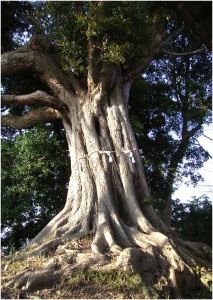Why do Japanese like to visit shrines? (2) 2015/01/31
In Japan, every village or settlement has it’s own shrine called as “chinnjusama” (the guardian of the village). A “chinnjusama” is the place for village people to gather on any occasions and every “chinnjusama” is always surrounded by natural woods which by any means have to be left untouched. Such natural woods have been considered as holly places and it is never forgiven to cut or destroy woods which are meant to guard the shrine.
Therefore such woods left untouched are the “Treasure island” for botanists to study the historical changes of natural woods.
According to “Kojiki”, Japanese oldest history book, after “Ohyashima” ( old name of Japan which means 8 big islands) was formed, many Gods were born one after another. However all of them are related with Nature. Such as God of stone, God of sea, God of river, God of wind, God of tree, God of field and so on. Then three vital Gods were born, namely “Amaterasu Omikami” ,founder of the Royal family and God of sun, “Tsukuyominokami”, God of moon and “ Susanonomikoto”, God of storm.
Historically and traditionally from the ancient time there have been uncountable numbers of Gods in Japan and we have as many Gods as they represent almost all natural phenomenon or scenery.
Nature and God are very close for Japanese and it might be possible to say God is the symbolized Nature. There are many mountains or high trees or large stones which are considered as Gods.
We have been enjoying so many blessings from Nature, therefore we,Japanese are not against Nature but have very close feeling with Nature. We need to be awesome and obedient sometime to Nature which, however, is still close to us.
Gods in Japan exist in completely different way from the God in monotheism world.








